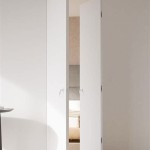Modern Minimalist Interior Design for Bedrooms
Modern minimalist interior design for bedrooms centers around the concept of simplicity, functionality, and tranquility. It aims to create a calming and uncluttered space that promotes relaxation and restful sleep. This design philosophy often emphasizes the elimination of excess, focusing instead on essential elements and clean lines. The aesthetics are generally characterized by neutral color palettes, natural materials, and a distinct lack of ornamentation. Understanding the core principles of modern minimalist design is key to achieving a bedroom that embodies both style and serenity.
The application of minimalist principles to bedroom design involves careful consideration of every element, from furniture selection to the arrangement of accessories. The goal is to create a space that is not only visually appealing but also functional and conducive to rest. This approach requires a thoughtful decluttering process, the removal of unnecessary items, and a commitment to maintaining a clean and organized environment. In essence, modern minimalist bedroom design seeks to strip away the superfluous and highlight the beauty of simplicity.
The Core Principles of Modern Minimalist Bedroom Design
Several key principles underpin modern minimalist bedroom design. These principles serve as guiding principles for creating a space that is both aesthetically pleasing and highly functional. Adhering to these principles ensures that the final result is a bedroom that reflects the core values of minimalism: simplicity, utility, and tranquility.
Decluttering and Organization
Decluttering is arguably the most important step in creating a minimalist bedroom. This involves thoroughly examining all items in the room and removing anything that is not essential or does not contribute to the overall aesthetic. This process extends beyond simply tidying up; it requires a conscious decision to eliminate excess belongings and to adopt a more curated approach to ownership. Organized storage solutions are then implemented to maintain a clean and clutter-free environment. Built-in wardrobes, under-bed storage, and minimalist shelving units are common choices, allowing for the discreet storage of personal items without compromising the room's minimalist aesthetic.
Effective storage is not merely about concealing clutter. It's about creating a system that promotes easy access to essential items while maintaining a streamlined appearance. For example, clothing might be organized by color and type, reducing visual clutter within the wardrobe. Similarly, bedside tables should be kept clear of unnecessary items, with only essential items such as a lamp and a book within reach. The objective is to create a space where everything has its place and where visual distractions are minimized.
Neutral Color Palettes and Natural Light
Modern minimalist bedrooms typically feature neutral color palettes. White, gray, beige, and other muted tones are frequently used to create a calming and serene atmosphere. These colors are often combined with natural materials such as wood, linen, and cotton to add warmth and texture to the space. The use of neutral colors helps to create a sense of spaciousness and allows natural light to become a focal point.
Maximizing natural light is another crucial aspect of minimalist bedroom design. Large windows are often incorporated to flood the room with sunlight, enhancing the sense of openness and airiness. Window treatments are typically kept simple and minimal, such as sheer curtains or blinds, to allow as much natural light as possible to enter the room. The interplay of natural light and neutral colors creates a soothing and relaxing environment that is conducive to rest and relaxation.
Simple Furniture and Clean Lines
Furniture in a minimalist bedroom is typically simple, functional, and devoid of unnecessary ornamentation. Clean lines and geometric shapes are favored over ornate details. Beds are often platform-style, with a low profile and a simple headboard. Other furniture pieces, such as bedside tables and dressers, are chosen for their functionality and their ability to blend seamlessly into the overall aesthetic. The focus is on quality over quantity, with each piece of furniture serving a specific purpose.
The arrangement of furniture is also carefully considered in minimalist bedroom design. Furniture should be placed in a way that maximizes space and allows for easy movement throughout the room. Overcrowding should be avoided, and each piece of furniture should have enough breathing room. The objective is to create a sense of spaciousness and tranquility, where the furniture is not only functional but also aesthetically pleasing.
Key Furniture and Accessories Choices
Selecting the right furniture and accessories is crucial for achieving a modern minimalist bedroom. Each item should be carefully chosen to contribute to the overall aesthetic and functionality of the space. Considerations should include not only the style of the item but also its durability, practicality, and its ability to complement the other elements in the room.
The Bed: A Minimalist Centerpiece
The bed is the focal point of any bedroom, and in a minimalist setting, it should be simple and elegant. A platform bed with a low profile is a popular choice, as it helps to create a sense of spaciousness and modernity. The headboard should also be simple and uncluttered, with clean lines and minimal ornamentation. The bedding should be equally minimalist, with neutral colors and simple patterns. High-quality materials such as linen or cotton are often preferred for their comfort and durability.
The size of the bed should be proportional to the size of the room. A large bed in a small room can make the space feel cramped and overcrowded. Conversely, a small bed in a large room can look out of place. Careful consideration should be given to the dimensions of the bed to ensure that it fits seamlessly into the overall design.
Storage Solutions: Functional and Discreet
Storage solutions are essential for maintaining a clutter-free minimalist bedroom. Built-in wardrobes are a popular choice, as they provide ample storage space without taking up too much floor space. Under-bed storage drawers are another practical option for storing bedding, clothing, or other personal items. Shelving units should be kept simple and minimal, with only essential items on display. The objective is to create a storage system that is both functional and discreet, seamlessly blending into the overall aesthetic of the room.
The choice of storage materials should also be carefully considered. Natural materials such as wood or bamboo are often preferred for their warmth and texture. Light-colored finishes can help to create a sense of spaciousness and airiness. Storage containers should be chosen for their functionality and their ability to complement the overall design. Clear containers can be useful for organizing items, while decorative boxes can add a touch of style to the space.
Lighting: Creating Ambiance
Lighting plays a crucial role in creating the right ambiance in a minimalist bedroom. Natural light should be maximized whenever possible, but artificial lighting is also important for creating a warm and inviting atmosphere. Simple and elegant lamps are often used to provide task lighting for reading or other activities. Recessed lighting can be used to provide ambient lighting, while accent lighting can be used to highlight specific features in the room.
The choice of light fixtures should be carefully considered to ensure that they complement the overall design. Simple and modern designs are often preferred, with clean lines and minimal ornamentation. The color temperature of the light bulbs should also be chosen to create the desired atmosphere. Warm white light is often preferred for bedrooms, as it creates a cozy and relaxing environment.
Implementing Minimalist Design in Existing Bedrooms
Transforming an existing bedroom into a minimalist haven requires a strategic approach, focusing on decluttering, simplifying, and refining the existing elements. This process involves a careful analysis of the current space and a deliberate effort to implement the core principles of minimalist design.
Start with Decluttering
The initial step involves a thorough decluttering process. All items within the bedroom should be evaluated, and anything deemed unnecessary or contributing to clutter should be removed. This includes clothing, accessories, decorative items, and any other belongings that are not essential to the functionality or aesthetic of the room. Consider donating, selling, or discarding these items to create a more streamlined space.
During the decluttering process, it is helpful to categorize items based on their necessity and sentimental value. Items that are frequently used and contribute to the functionality of the room should be kept, while items that are rarely used or serve no practical purpose should be removed. Sentimental items can be stored in a designated area, such as a memory box, to keep them organized and out of sight.
Simplify Furniture and Decor
After decluttering, the next step is to simplify the furniture and decor. This involves removing any unnecessary furniture pieces and replacing them with more functional and minimalist alternatives. Ornate or bulky furniture should be replaced with simple and streamlined designs. Similarly, excessive decorative items should be removed, leaving only a few carefully chosen pieces to add visual interest to the room.
When selecting furniture and decor, focus on quality over quantity. Choose a few high-quality pieces that are both functional and aesthetically pleasing. Opt for neutral colors and simple patterns to create a calming and serene atmosphere. Avoid overcrowding the room with too many items, and instead, focus on creating a sense of spaciousness and tranquility.
Refining Details and Finishing Touches
The final step in transforming an existing bedroom into a minimalist haven involves refining the details and adding the finishing touches. This includes updating the bedding with neutral colors and simple patterns, adding a few carefully chosen accessories, and ensuring that the room is well-organized and clutter-free. Pay attention to the small details, such as the placement of lamps and the arrangement of books, to create a cohesive and harmonious design.
Consider adding a few plants to the room to bring a touch of nature indoors. Plants can help to purify the air and create a more relaxing atmosphere. Choose simple and elegant planters to complement the minimalist aesthetic. With careful planning and attention to detail, it is possible to transform an existing bedroom into a minimalist sanctuary that promotes relaxation and restful sleep.

Minimalist Bedrooms That Are Gorgeous And Practical Bedroom Ideas

Comprehensive Guide To Minimalist Interior Design And Academy

Minimalist Bedroom D Cor Ideas To Simplify Your Interiors Beautiful Homes

40 Modern Minimalist Bedroom Design Ideas Matchness Com

Minimalistic Bedroom Design Ideas For Modern N Homes

40 Modern Minimalist Bedroom Design Ideas Matchness Com

Soothing Minimal Bedroom Design Ideas Hommés Studio

62 Minimalist Bedroom Ideas That Are Anything But Boring Interiorzine

13 Minimalist Bedrooms That Prove Less Really Is More Luxe Interiors Design

Secret Techniques To Improve Modern Minimalist Bedroom Ideas
Related Posts








